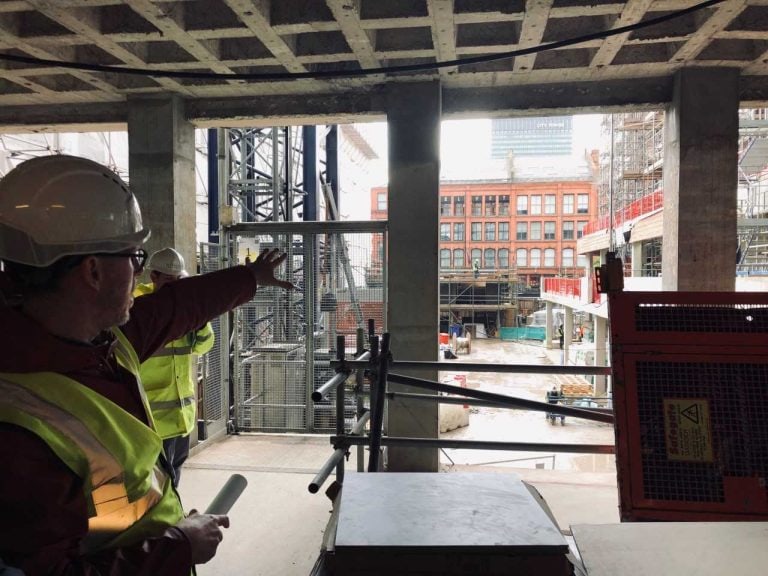UKGBC members explore KAMPUS development in Manchester

On 20 June in central Manchester, a group of UKGBC members explored the site of the KAMPUS development. Once home to Manchester’s Metropolitan University, the site is being transformed into a new £250 million, mixed used neighbourhood by Henry Boot Developments Ltd and Capital & Centric. The project lead, Chris Stalker, explained how the design of KAMPUS responds to its context and makes use of existing buildings and materials, demonstrating that circular resource use can add value and help to create interesting places..
The design celebrates the history of the site. The tour included an opportunity to see the regeneration of a reclaimed 1960’s brutalist tower block with its original concrete ‘waffle’ ceilings exposed in the new apartments and two listed, Victorian former-cotton warehouses which will become loft-style apartments with exposed brickwork and heritage features. The tour also included a walk along Little David Street, which will form part of a re-opened cobbled street of independent restaurants and shops leading to a lush garden next to the canal. Chris explained the challenges presented by keeping the original 1960s tower and working with the listed buildings, but noted that the end result would be a uniquely different collection of buildings which will provide a broad appeal to residents and commercial tenants.
The ability to adapt to market changes and future building use increases the longevity of a development, keeping existing materials in use and negates the need to demolish and rebuild. UKGBC’s Circular Economy Guidance for Construction Clients identifies keeping products and materials in use as one of the principle factors in a circular model of construction.
The KAMPUS project’s design also includes measures that enhance biodiversity and wellbeing. The site is being transformed into over 500 apartments with a lush secret garden, surrounded by places to eat and drink, at its heart. The outdoor greenery is designed to create a sense of enclosure, with densely-planted and varied tree species, selected for their urban resilience.. The gardens will be accessible to the public and residents alike from all four corners of the site, opening up previously forgotten spaces for the city to enjoy.. (Find out more about how increasing green infrastructure can benefit people, places and planet in our new Course Mail learning tool on Nature and Biodiversity).
Jo Thetford, UKGBC’s Local Network Coordinator in Manchester and Principal Sustainability Consultant at Hilson Moran said:
“I have seen Manchester evolve dramatically over the last two decades into the thriving European city that it is today. I been really excited to watch the KAMPUS project growing and it’s great to see circular economy, wellbeing and nature and biodiversity principles being incorporated into commercial strategies like this.”
Mark Cunliffe from BuroHappold, the structural engineers on the project, gave us a technical overview of how the structure responds to climate impacts. The urban drainage systems (SUDs) for example, involve collecting discharge in the local Shooters Brook, providing attenuation of surface run-off. Mark made a poignant parallel with the rise in understanding of onsite Health and Safety responsibilities, reminding us:
“We’re now all responsible for the sustainability of the built environment. New projects can balance efficiency in construction with a commitment to a long-term vision.”
We’d like to thank our speakers: Chris Stalker from KAMPUS, Mark Cunliffe and Georgina Chamberlain from BuroHappold and Jo Thetford from Hilson Moran, for their contribution to the tour and their insights and expertise, and to Capital & Centric and Henry Boot Developments Ltd for hosting the tour.
UKGBC is always interested to hold learning tours of this nature on other sites, either under construction or completed, so please do let us know if you have a development UKGBC members could learn from.
Related
Navigating the challenges around hard-to-recycle materials

What are the environmental impacts of construction materials? An introduction to Embodied Ecological Impacts

Why is social value so crucial when developing and managing commercial real estate?

Biodiversity Net Gain: Are you ready for the incoming legislation?

